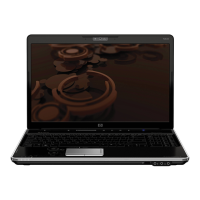Maintenance and Service Guide 8–1
8
Backup and Recovery
Recovering system information
Recovery after a system failure is as complete as your most current backup. HP recommends that you create
recovery discs immediately after software setup. As you add new software and data files, you should continue to
back up your system on a regular basis to maintain a reasonably current backup.
Tools provided by the operating system and Recovery Manager software are designed to help you with the
following tasks for safeguarding your information and restoring it in case of a system failure:
■ Creating a set of recovery discs (Recovery Manager software feature). Recovery discs are used to start up
(boot) your computer and restore the operating system and software programs to factory settings in case of
system failure or instability.
■ Backing up your information regularly to protect your important system files.
■ Creating system restore points (operating system feature). System restore points allow you to reverse
undesirable changes to your computer by restoring the computer to an earlier state.
■ Recovering a program or driver (Recovery Manager software feature). This feature helps you reinstall a
program or driver without performing a full system recovery.
■ Performing a full system recovery (Recovery Manager software feature). With Recovery Manager, you can
recover your full factory image if you experience system failure or instability. Recovery Manager works from
a dedicated recovery partition (select models only) on the hard drive or from recovery discs you create.
✎
Computers with a solid-state drive (SSD) may not have a recovery partition. Recovery discs have been included
for computers that do not have a partition. Use these discs to recover your operating system and software. To
check for the presence of a recovery partition, select Start, right-click Computer, click Manage, and then click
Disk Management. If the partition is present, an HP Recovery drive is listed in the window.
Creating recovery discs
HP recommends that you create recovery discs to be sure that you can restore your system to its original factory
state if you experience serious system failure or instability. Create these discs after setting up the computer for the
first time.
Handle these discs carefully and keep them in a safe place. The software allows the creation of only one set of
recovery discs.
Note the following guidelines before creating recovery discs:
■ You will need high-quality DVD-R, DVD+R, BD-R (writable Blu-ray), or CD-R discs. All these discs are
purchased separately. DVDs and BDs have a much higher capacity than CDs. If you use CDs, up to 20 discs
may be required, whereas only a few DVDs or BDs are required.
✎
Read-write discs, such as CD-RW, DVD±RW, double-layer discs, and BD-RE (rewritable Blu-ray) discs, are not
compatible with the Recovery Manager software.
■
The computer must be connected to AC power during this process.
■ Only one set of recovery discs can be created per computer.
■ Number each disc before inserting it into the optical drive.

